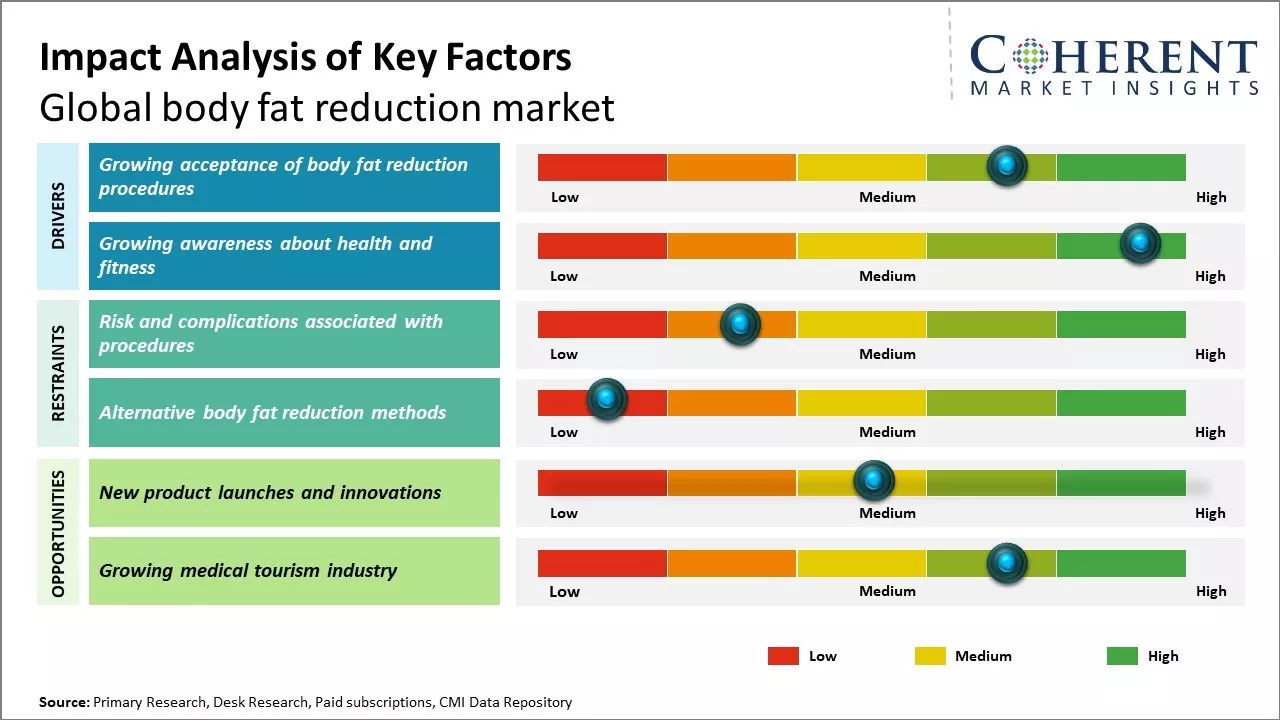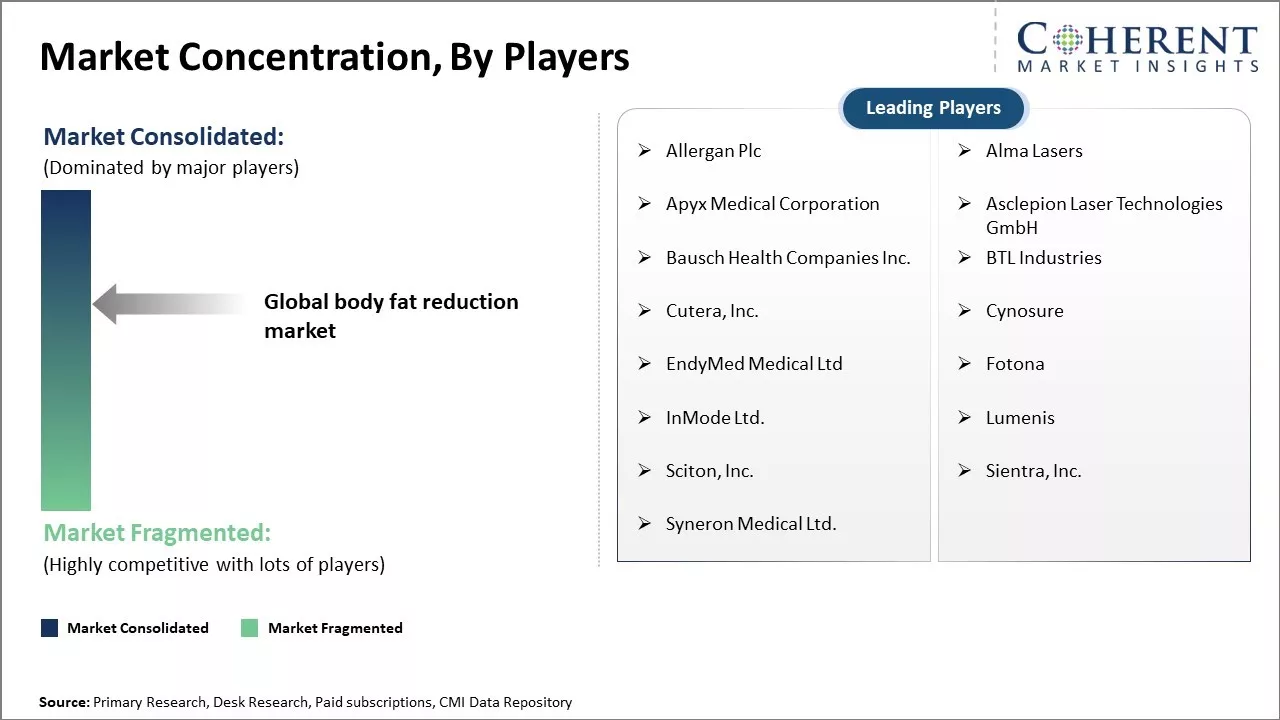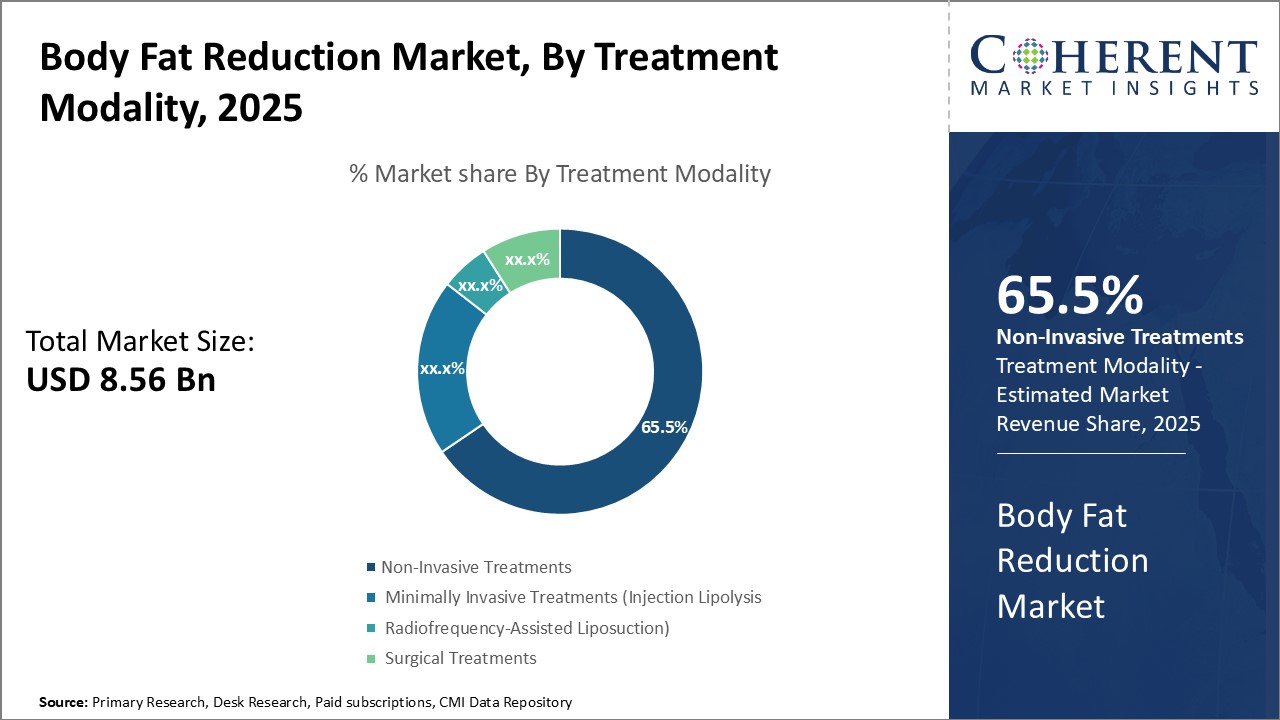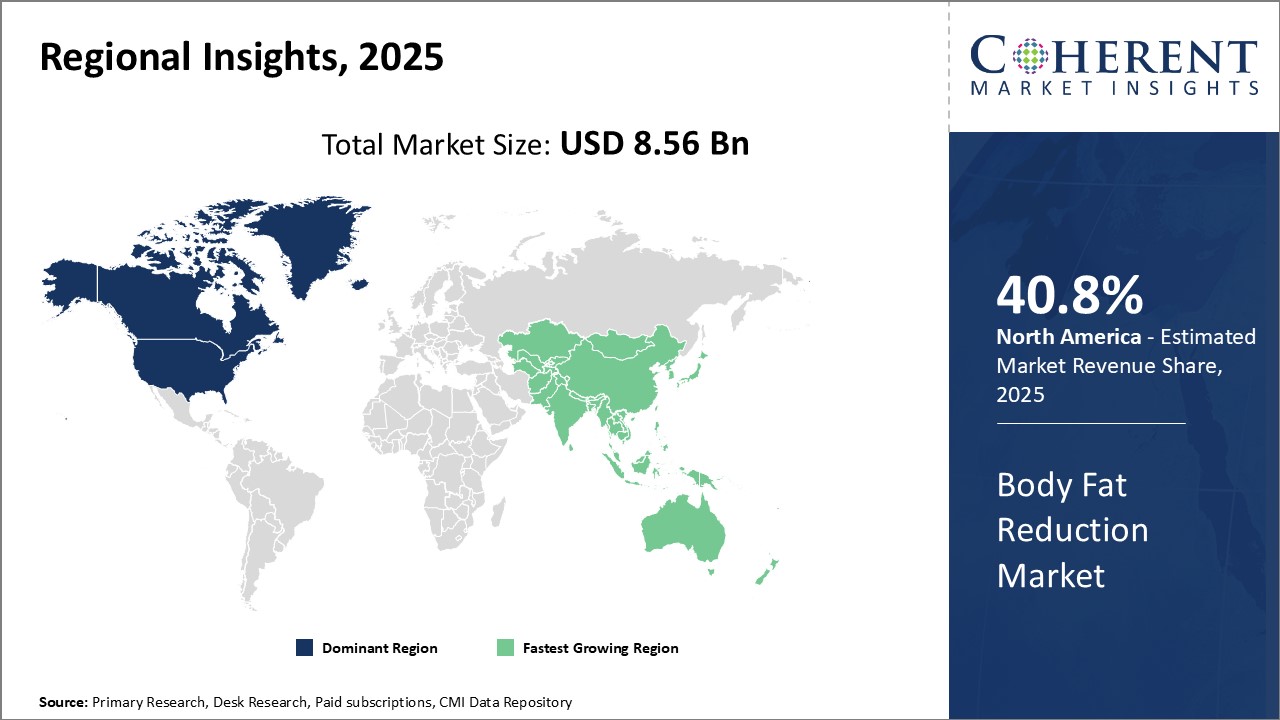Body Fat Reduction Market Size and Trends
Global body fat reduction market is estimated to be valued at USD 8.56 Billion in 2025 and is expected to reach USD 15.65 Billion by 2032, exhibiting a compound annual growth rate (CAGR) of 9.0% from 2025 to 2032.

Discover market dynamics shaping the industry: Download Free Sample
Growing obesity rates worldwide due to changing lifestyles and increasing consumption of junk food has boosted demand for effective body fat reduction treatment methods. Various non-invasive procedures such as cryolipolysis, ultrasound and laser lipolysis are gaining popularity as these offer minimal downtime and lower risk compared to invasive surgeries. Rising consumer awareness about physical appearance and weight management has increased adoption of both surgical and non-surgical fat reduction treatments. Manufacturers are also investing in research & development of innovative products to offer enhanced results. Introduction of technologically advanced devices can drive the body fat reduction market growth in the future.
Growing acceptance of body fat reduction procedures
Growing social acceptance of different body fat reduction procedures across the world can drive the market growth. While such practices may have attracted some controversy or social taboo in the past, people seem to be becoming far more open-minded about consciously trying to reduce excess body fat these days. This shift in social attitudes can drive the market growth. From minimally-invasive procedures such as cryolipolysis and ultrasound-assisted liposuction to more involved techniques like breast reduction surgery and tummy tucks, the menu of medicalized options for improving body contour and shape has widened considerably in recent times. There has been less stigmatization of people's decisions to sculpt their bodies in clinics. The emphasis lies on achieving improved physical and mental well-being, rather than just on looks. This makes more individuals feel empowered about undergoing such procedures without fearing adverse judgment from others. Increasing visibility have eased social conditioning. Popular culture and new-age media platforms are vibrant with inspiration depicting courageous journeys of radical transformations. Stories of everyday people flaunting their newfound confidence after committing to body sculpting give hope and encouragement to those still on the fence. While doubts may linger privately for some people, there is growing social proof that seeking professional can tackle problem areas need not be viewed negatively anymore by default.
Market Concentration and Competitive Landscape

Get actionable strategies to beat competition: Download Free Sample
Growing awareness about health and fitness
With increasing screen time and sedentary desk jobs dominating mainstream careers, non-communicable lifestyle diseases have emerged as pressing societal challenges. Individuals across age groups are bombarded daily with images and narratives glorifying fit bodies through different media platforms. While these glamourized projections may sometimes be unrealistic, these have undoubtedly raised consciousness around linking health with aspects like weight management and body composition. This has highlighted the role of reducing excess body fat through medical procedures. Greater access to knowledge means more persons are linking carrying excess abdominal or subcutaneous fat with elevated risks of cardiac issues, diabetes, arthritis and certain cancers. Scientific literature is replete with studies emphasizing how losing even modest amounts of weight, especially around the waist, can yield significant returns in reducing the incidence or severity of chronic conditions over the long-run.
Mainstream wellness gurus and social media stars have turbocharged demand for all things health and fitness by preaching lifestyle optimization is a necessity, not a vanity pursuit. This has boosted the appeal of body sculpting techniques, which help remove stubborn fat deposits from trouble areas in a targeted manner, without major invasive effort or downtime. The search for an attractive, toned physique has also become intertwined with enhancing quality of life and mental wellness for many people. Pressures of performing at peak levels within cut-throat professional environments and on social platforms make looking and feeling one’s best increasingly important. Having a softer, bulging mid-section or double chin is no longer acceptable to a generation that sees fitness as a lifestyle essential. This has upped the motivation to invest in non-invasive body contouring solutions for sculpting a shape associated with higher self-esteem and presence. In essence, prioritizing health, self-optimization, and preventing future risks boosts popularity of body fat reduction services.
Key Takeaways from Analyst:
Global body fat reduction market growth is driven by rising obesity rates worldwide due to unhealthy eating habits and sedentary lifestyles. Growing health consciousness among people can also drive the market growth as more individuals want non-invasive and effective ways to reduce excessive body fat. Technological advancements allowing for minimally invasive procedures can boost the market expansion.
High costs associated with certain advanced body fat reduction treatments may discourage some consumers. Strict regulations pertaining to the safety and efficacy of these procedures can hamper the market growth. Lack of reimbursement coverage makes these treatments unaffordable for many people.
Increasing popularity of non-invasive treatments over invasive surgeries offers growth opportunities. Emerging Asian economies are also expected to witness rapid uptake as obesity becomes a concern for their developing middle class. North America currently dominates the market but Asia Pacific is expected to be the fastest growing region. Social media influence regarding fitness and appearances has also boosted demand for body fat treatment among younger individuals.
Market Challenges: Risk and complications associated with procedures
Global body fat reduction market growth can be hampered due to risks and complications associated with various invasive procedures. Many surgical procedures such as liposuction carry the risk of infection, blood clots, organ damage, and adverse reactions to anesthesia. Procedures such as cryolipolysis and ultrasound-assisted lipolysis also come with potential side effects like bruising, pain, numbness and weakening of fat cells. With any medical treatment or procedure, especially those involving surgical or minimally invasive interventions, there is a chance of complications occurring. The industry needs to continuously focus on minimizing these risks through proper screening of patients, improving techniques and technologies, and educating people about the potential dangers involved. Transparency regarding success and failure rates is also important to manage public perception and trust in these procedures. Addressing concerns over safety can boost growth of the body fat reduction industry.
Market Opportunities: New product launches and innovations
New product launches and ongoing innovations can offer market growth opportunities. With rising health awareness and an increased emphasis on physical appearance, people are constantly looking for newer and more effective solutions. Developers and companies have an incentive to invest in R&D to discover advanced technologies that can remove fat deposits in a less invasive manner compared to existing options. Some examples include focused ultrasound, radio frequency devices, non-invasive body sculpting techniques and food supplements promising fat loss. With continued advancements, more minimally invasive and lower risk options will become available. This helps expand the potential customer base as procedures become less daunting. Innovation has the power to accelerate market expansion by addressing unmet needs and keeping consumers engaged.

Discover high revenue pocket segments and roadmap to it: Download Free Sample
By Treatment Modality - Advances in Non-Invasive Technologies Drive Growth of Non-Invasive Treatments Segment
In terms of treatment modality, non-invasive treatments segment is expected to contribute the highest market share of 65.5% in 2025, owing to advancements in cryolipolysis, radiofrequency, and laser-assisted procedures. Technological improvements have made these treatment options more effective and comfortable for patients while yielding natural-looking results. Cryolipolysis utilizes controlled cooling to target and eliminate fat cells without major discomfort or downtime. As technology enhances the application of localized cold temperatures, more body areas can be treated efficiently. Radiofrequency devices have also evolved to deliver circumferential heating at variable depths below the skin's surface. This allows for comprehensive fat cell destruction in trouble areas like the abdomen, thighs, and back. Innovations in laser wavelengths and emission patterns allow laser-assisted lipolysis to treat larger treatment zones at once with minimal adverse effects. The advent of new hybrid treatment modalities that combine technologies can increase efficacy rates and drive greater adoption of non-invasive fat reduction worldwide. For example, the combination of laser and radiofrequency in a single procedure can reduce fat cells while tightening skin. The non-invasive nature and tangibility of immediate results without invasive procedures have boosted the popularity of treatment options such as cryolipolysis and radiofrequency among consumers. Advancements addressing current limitations can sustain the leading position of non-invasive modalities in the market.
By Target Body Area - Focus on Core Areas Boosts Minimally Invasive Treatments
In terms of target body area, abdomen segment is expected to contribute the highest market share of 40.5% in 2025, owing to higher demand for visceral fat reduction in this area. Minimally invasive procedures are well-suited to efficiently reduce abdominal fat, owing to refinements in injection lipolysis and radiofrequency-assisted technologies. Injection lipolysis utilizes injected pharmaceutical compounds to rupture fat cells in the abdomen, flanks, and other problem spots. Modern injection techniques and medication formulations have made the process more tolerable while maintaining efficacy. Radiofrequency-assisted liposuction combines traditional liposuction with RF energy delivery through cannulas. The RF component melts fat prior to suction, allowing for treatment of fibrous fat difficult to remove otherwise. It has found widespread adoption for abdominal sculpting. Procedures delivering minimally invasive contouring of core body regions help meet the growing need for visceral fat management and six-pack abdomen achievement in many countries. Greater focus of innovation on refinement of injection and RF-assisted techniques for core reduction can sustain their preference over surgical options.
By End User - Emphasis on Non or Minimally Invasive Options Drives Growth of Dermatology Clinics Segment
In terms of end user, dermatology clinics segment is expected to contribute the highest market share of 35.5% in 2025, as these offer primarily non- and minimally invasive body contouring options. The inclination towards minimally disruptive treatments aligns with the type of services traditionally provided at dermatology centers. Techniques such as cryolipolysis, radiofrequency, and injection lipolysis allow fat reduction without major downtime or risk of surgical complications. This appeal has boosted their adoption at dermatology practices worldwide. It has also encouraged many such facilities to invest in newer non-invasive devices to offer cutting-edge body contouring options. Growing access to specialized dermatologists trained in cosmetic procedures also drives consumers to opt for services at dermatology clinics. Their minimally discomforting nature and ability to achieve natural-looking results without surgery attract more patients. Many individuals opt to try non-invasive treatments prior to considering surgical methods. These drives repeat visits and package purchases. As non-invasive options continue advancing, their availability at dermatology centers will sustain high patient volumes in this end user segment.
Regional Insights

Need a Different Region or Segment? Download Free Sample
North America dominates the global body fat reduction market with an estimated market share of 40.8% in 2025, owing to growing health and fitness consciousness among the population. With high disposable income and spending on personal care, the U.S. accounts for over 40.5% of the total regional market revenue. There has been increasing demand for non-invasive and minimally invasive body contouring treatments to get rid of excess fat without major surgery.
Laser liposuction and other energy-based device treatments form the largest revenue generating segment in North America. The availability of advanced medical technologies, skilled professionals and efficient infrastructure provides patients with quick and reliable services. Several leading global companies have established their hubs in the region to cater to this high-demand market. Moreover, the proximity to Asia Pacific helps strengthen the import-export activities and supply chain management. The adoption of novel fat reduction approaches is also influenced by active social media presence and changing beauty standards in North America. With growing obesity levels and sedentary lifestyles, non-surgical body sculpting solutions have become mainstream for targeted fat loss without major downtime.
Market Report Scope
Body Fat Reduction Market Report Coverage
| Report Coverage | Details | ||
|---|---|---|---|
| Base Year: | 2024 | Market Size in 2025: | USD 8.56 Bn |
| Historical Data for: | 2020 To 2024 | Forecast Period: | 2025 To 2032 |
| Forecast Period 2025 to 2032 CAGR: | 9.0% | 2032 Value Projection: | USD 15.65 Bn |
| Geographies covered: |
|
||
| Segments covered: |
|
||
| Companies covered: |
Allergan Plc, Alma Lasers, Apyx Medical Corporation, Asclepion Laser Technologies GmbH, Bausch Health Companies Inc., BTL Industries, Cutera, Inc., Cynosure, EndyMed Medical Ltd, Fotona, InMode Ltd., Lumenis, Sciton, Inc., Sientra, Inc., and Syneron Medical Ltd. |
||
| Growth Drivers: |
|
||
| Restraints & Challenges: |
|
||
Uncover macros and micros vetted on 75+ parameters: Get instant access to report
Body Fat Reduction Industry News
- In March 2024, Amgen differentiated itself in the competitive weight loss market with its injectable treatment, MariTide, which not only aids in weight loss but also helps maintain weight loss after discontinuation
- In April 2023, Eli Lilly and Company announced that tirzepatide (10 mg and 15 mg) demonstrated superior weight loss as compared to placebo over 72 weeks in the SURMOUNT-2 study. Participants using tirzepatide lost up to 15.7% of their body weight. This phase 3 trial, involving 938 adults with obesity or overweight and type 2 diabetes, met all primary and secondary objectives for efficacy and safety.
- In February 2022, Givaudan introduced PrimeLock+, a patent-pending, natural, vegan-friendly solution designed to enhance plant-based products. It mimics animal fat cells to improve the taste, texture, and juiciness of plant-based foods, addressing common issues like oil loss during cooking. This innovation helps food manufacturers elevate consumer satisfaction by better preserving flavor and texture.
- In May 2021, Allergan Aesthetics acquired Soliton, a company known for its rapid acoustic pulse device used in non-invasive treatments to temporarily enhance the appearance of cellulite. This acquisition broadened Allergan Aesthetics' range of body contouring treatments.
*Definition: Global body fat reduction market encompasses a range of products, services, and techniques designed to help individuals reduce excess body fat safely and gradually. This market includes items such as body wraps, creams, and supplements that claim to enhance fat burning or support slimming efforts when used alongside diet and exercise. It also features thermal methods like low-level laser treatments, cryolipolysis, and radiofrequency treatments. The aim is to achieve a leaner, healthier body composition through scientifically-supported fat reduction solutions.
Market Segmentation
- Treatment Modality Insights (Revenue, USD Bn, 2020 - 2032)
- Non-Invasive Treatments
- Cryolipolysis
- Radiofrequency
- Laser-Assisted Lipolysis
- Ultrasound
- Other Non-Invasive Treatments
- Minimally Invasive Treatments
- Injection Lipolysis
- Radiofrequency-Assisted Liposuction
- Surgical Treatments
- Traditional Liposuction
- Abdominoplasty
- Non-Invasive Treatments
- Target Body Area Insights (Revenue, USD Bn, 2020 - 2032)
- Abdomen
- Thighs
- Hips and Buttocks
- Arms
- Multiple Body Areas
- End User Insights (Revenue, USD Bn, 2020 - 2032)
- Dermatology Clinics
- Plastic Surgery Clinics
- Hospitals and Ambulatory Surgical Centers
- Medical Spas and Beauty Clinics
- Regional Insights (Revenue, USD Bn, 2020 - 2032)
-
- North America
- S.
- Canada
- Latin America
- Brazil
- Argentina
- Mexico
- Rest of Latin America
- Europe
- Germany
- K.
- Spain
- France
- Italy
- Russia
- Rest of Europe
- Asia Pacific
- China
- India
- Japan
- Australia
- South Korea
- ASEAN
- Rest of Asia Pacific
- Middle East
- GCC Countries
- Israel
- Rest of Middle East
- Africa
- South Africa
- North Africa
- Central Africa
- North America
- Key Players Insights
- Allergan Plc
- Alma Lasers
- Apyx Medical Corporation
- Asclepion Laser Technologies GmbH
- Bausch Health Companies Inc.
- BTL Industries
- Cutera, Inc.
- Cynosure
- EndyMed Medical Ltd
- Fotona
- InMode Ltd.
- Lumenis
- Sciton, Inc.
- Sientra, Inc.
- Syneron Medical Ltd.
Share
Share
About Author
Manisha Vibhute is a consultant with over 5 years of experience in market research and consulting. With a strong understanding of market dynamics, Manisha assists clients in developing effective market access strategies. She helps medical device companies navigate pricing, reimbursement, and regulatory pathways to ensure successful product launches.
Missing comfort of reading report in your local language? Find your preferred language :
Transform your Strategy with Exclusive Trending Reports :
Frequently Asked Questions
EXISTING CLIENTELE
Joining thousands of companies around the world committed to making the Excellent Business Solutions.
View All Our Clients
